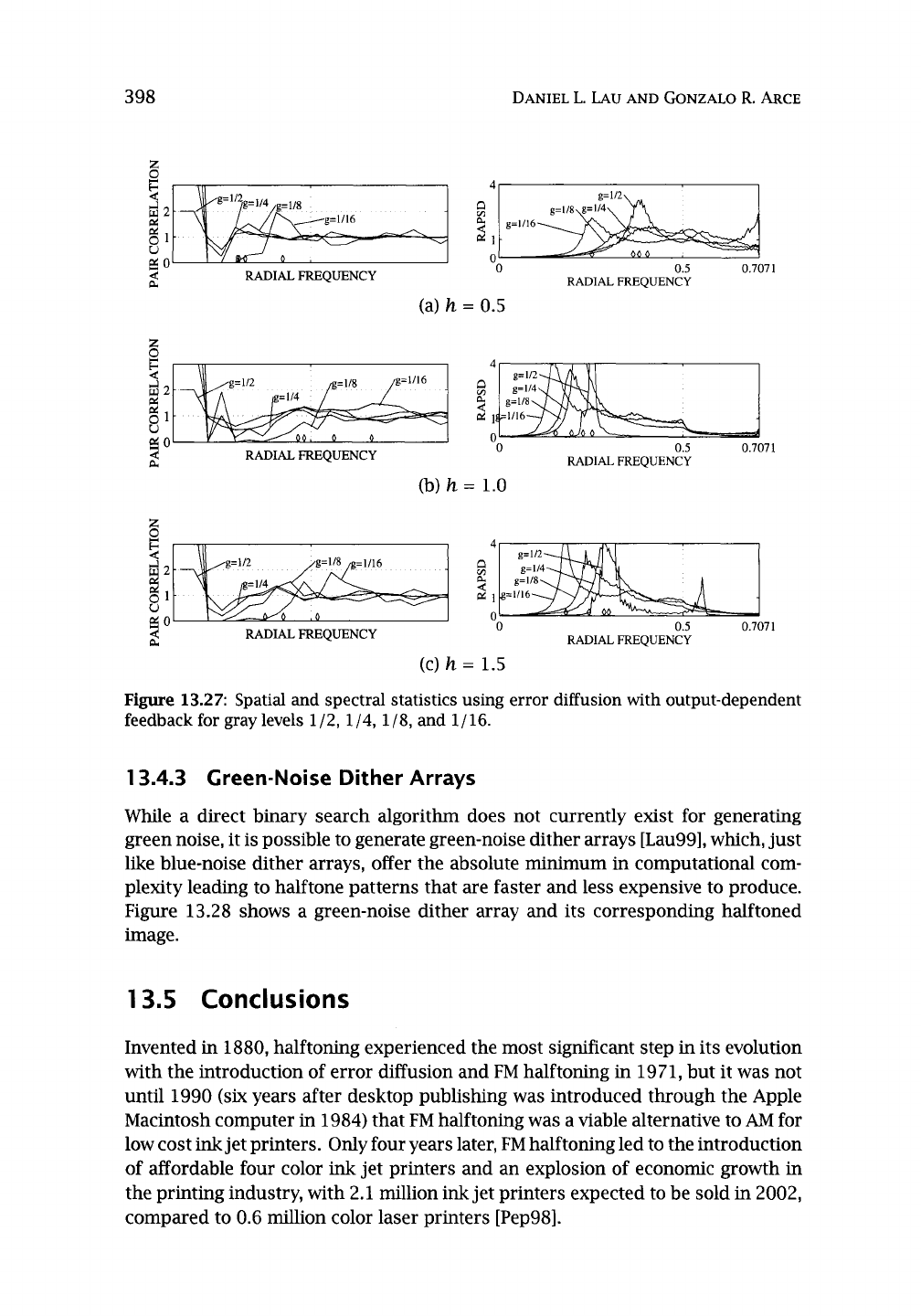
398 DANIEL L. LAU AND GONZALO R. ARCE
z
9
[--"~g= I/~g= 1/4/g= i/8
.]
2 ..............................................
r.)
~o
<
RADIAL FREQUENCY
4 l g=l/2\ ~ [
g= 1/8"~=.1/4 ~ I'~ ::
0 0.5 0.7071
RADIAL FREQUENCY
(a) h = 0.5
z
9
1
2L_ l g-l,2 .g=i,.6 ]
~0 RADIAL FREQUENCY
4
~ I g=l/4",~ ~'-~ ~
0'- ~-.:--.=--- v ~ v v -----~.- i
0 0.5 0.7071
RADIAL FREQUENCY
(b) h = 1.0
1 ~ 0
~0 RADIAL FREQUENCY
4 ......
/
g=l/8"~ -~r~,_ i
0
0 0.5 0.7071
RADIAL FREQUENCY
(c) h = 1.5
Figure 13.27: Spatial and spectral statistics using error diffusion with output-dependent
feedback for gray levels 1 / 2, 1 / 4, 1 / 8, and 1 / 16.
13.4.3 Green-Noise Dither Arrays
While a direct binary search algorithm does not currently exist for generating
green noise, it is possible to generate green-noise dither arrays [Lau99], which, just
like blue-noise dither arrays, offer the absolute minimum in computational com-
plexity leading to halftone patterns that are faster and less expensive to produce.
Figure 13.28 shows a green-noise dither array and its corresponding halftoned
image.
1 3.5 Conclusions
Invented in 1880, halftoning experienced the most significant step in its evolution
with the introduction of error diffusion and FM halftoning in 1971, but it was not
until 1990 (six years after desktop publishing was introduced through the Apple
Macintosh computer in 1984) that FM halftoning was a viable alternative to AM for
low cost ink jet primers. Only four years later, FM halftoning led to the introduction
of affordable four color ink jet printers and an explosion of economic growth in
the printing industry, with 2.1 million ink jet printers expected to be sold in 2002,
compared to 0.6 million color laser printers [Pep98].

CHAPTER 13: DIGITAL HALFTONING
399
Figure 13.28: (a) Green-noise dither array and (b) resulting halftoned image.
Today, we stand on the verge of a new technological revolution in printing
as printers are achieving ultrahigh resolutions, but to take full advantage of the
smaller dot sizes, a fundamental change must occur in the manner in which
printed dots are arranged. Green noise represents that fundamental change, and
as green noise is extended from theory to practice, the number of algorithms that
generate it will dramatically increase since only a handful currently exist. Issues of
particular importance include computational complexity and color reproduction.
References
[Ami94] I. Amidor, R. D. Hersch, and V. Ostromoukhov. Spectral analysis and mini-
mization of Moir~ patterns in color separation.
J. Electron. Imag.
3(7), 295-317
(July 1994).
[Ana92] M. Analoui and J. P. Allebach. Model based halftoning using direct binary
search. In
Human Vision, Visual Processing, and Digital Display III,
Proc. SPIE
Vol. 1666, pp. 96-108 (August 1992).
[Bar64a] M. S. Bartlett. The spectral analysis of a point process.
J. R. Statist. Soc.
Ser. B
25(2), 264-280 (February 1964).
[Bar64b] M. S. Bartlett. The spectral analysis of two-dimensional point processes.
Biometrika
51(12), 299-311 (December 1964).
[Bla93] D. Blatner and S. Roth.
Real World Scanning and Halftones.
Addison-Wesley,
Berkeley, CA ( 1993).
[Cam96] F.W. Campbell, J. J. Kulikowski, and J. Levinson. The effect of orientation
on the visual resolution of gratings.
J. PhysioL
187(2), 427-436 (November
1996).
Get Nonlinear Image Processing now with the O’Reilly learning platform.
O’Reilly members experience books, live events, courses curated by job role, and more from O’Reilly and nearly 200 top publishers.

